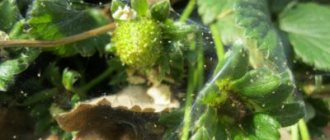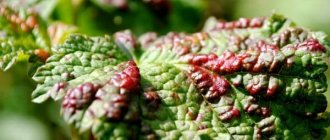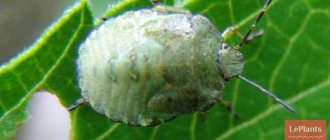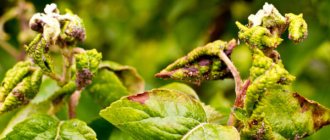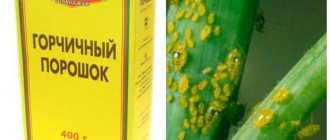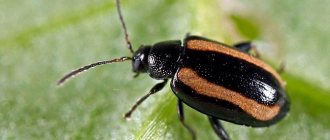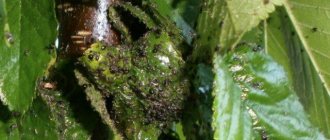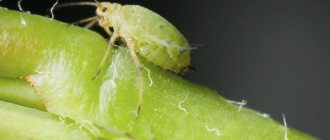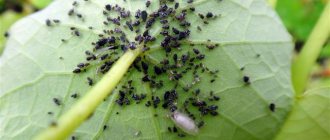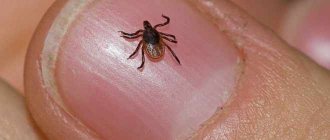The gall mite on a pear is not such a rare phenomenon. After all, they like this culture the most. If you do not control parasites in a timely manner, you can lose not only pear plantings, but also other fruit trees in the garden. Signs, causes of appearance, methods of getting rid of gall mites, preventive measures - this is what gardeners need to know.
Description of the pest
This small insect has an elongated body no more than 0.2 mm long. If you look at the photo, you will notice that the tick looks like a worm. It has 2 pairs of legs and a piercing-sucking mouth. Most adults are females. It feeds on the sap of fruit trees. Its larvae are brought to the site by the wind, birds and insects. For the winter they hide under the scales of the buds.
After the air warms up, the females begin to lay eggs. Several generations are born during the season. The task of the first ones is to reproduce and parasitize on trees; in the middle of summer, the last generation begins to penetrate the buds in order to overwinter there, waiting for the next spring.
Flower beetle
Flower beetles appear on young pears in the spring, when buds form on the pear. They feed on their juice. The insect destroys the entire crop.
Flower beetles are a type of weevil. The appearance of these beetles is a serious cause for concern. They bite through a flower bud filled with juice. The tree stops blooming and bearing fruit.
You can fight the flower beetle using agrotechnical, preventive methods and the use of chemical insecticides. In the spring, clean the bark, whitewash and install adhesive belts. The biological insecticides Decis and Kinmiks help.
The danger of pear gall mite
The gall mite is dangerous in the sense that because of it, new shoots slow down their growth, it spoils the buds, ovaries, and buds. Because the buds are damaged, changes occur in the leaves and photosynthesis is disrupted. The ovaries turn out ugly, fall off prematurely or do not form at all. Infectious agents easily penetrate through the punctures they leave. The tree begins to lack nutrients.
If a gall mite is detected on a pear, control measures must be taken immediately, otherwise the crop losses will be colossal - up to 95%. And young seedlings can quickly die from a massive pest invasion.
What harm does the pear do?
The pear gall mite is not capable of destroying an adult pear. But it contributes to the deterioration of the immune system, which means the tree will not be able to fight numerous fungal and infectious diseases. The appearance also suffers greatly. As for young pears. Then the tick contributes to:
- a significant reduction in the number of fruits;
- damage, destruction of ovaries and buds;
- destruction of the kidneys;
- slowing down the development and growth of young shoots.
Since the tick overwinters in the kidneys, the damaged areas freeze. The tree cannot obtain the elements necessary for nutrition, which in severe frosts will accelerate the decline in immunity. Subsequently, the pear will die.
Signs and causes of ticks
In spring, buds affected by the pest are clearly visible. Although they are quite large in size, their development is delayed by about 14 days. If some buds have already opened, and other larger ones do not even form, it can be assumed that a gall mite lived in them during the winter.
Attention!
It is necessary to more closely examine the bottom and middle of the crown as close to the trunk as possible.
After the females emerge from the buds, they begin to suck the juice from the young leaves, pierce them and lay eggs. When infected, you can see 2 swollen stripes on the leaf. The damage resembles greenish blisters, their length is 3 mm. Gradually, the pests turn dark brown and cover the entire surface. Over time they become black. If there is no control of the mite on the pear, the damaged leaves twist and fall off.
In addition to wind, birds and insects, gall mites can appear if sanitary pruning of the crown is not carried out for a long time. The appearance of the parasite is caused by an excessive amount of phosphorus fertilizers, certain stimulant drugs and insecticides, due to which insects die, for example, dragonflies, which destroy this pest.
Aphid
Aphids give birth about 16 times per season. The larvae hatch in the spring from eggs laid in cracks in the bark last year. This insect causes enormous damage to fruit trees:
- Young shoots dry out and stop growing;
- Insects carry fungal and viral diseases, such as sooty fungus. As a result, the plant withers, the process of photosynthesis is disrupted, and the pear slowly dies.
The fight should start with preventive measures. To prevent aphids from appearing on the pear, you must:
- In the fall, remove the old bark, treat the trunk with an antiseptic, cover the cracks with varnish, and whitewash the tree.
- Before wintering, be sure to dig up the soil around the pear.
- In the fall, pour boiling water over the bark at 80 degrees. This is not harmful to the tree, and the aphids die.
- In the spring, glue a sticky belt to the trunk to catch aphids and ants crawling up the trunk.
We have already written in more detail about the fight against aphids earlier. We recommend that you read the information on how to get rid of aphids in your dacha, because aphids easily settle on fruit trees and flowers in a flower bed.
Treat the pear tree against aphids before buds appear with insecticides, for example, Kinmiks. Before the flowers bloom - Agravertine, and when the fruits set - Iskra.
Treatment with folk remedies helps against aphids:
- Rinsing the tree crown and trunk with a stream of cold water;
- Spraying with soap solution;
- Treating leaves with infusion of garlic, onion, wormwood, and dandelion.
Chemicals for tick control
One of the most effective methods for protecting and destroying gall mites is treatment with chemicals.
Processing is carried out in 3 stages:
- the first time when it gets warm and the pests crawl out of their hiding places;
- in summer after flowering;
- after harvesting the fruits, before frost sets in.
Mining moths
Moths are a dangerous pest that can easily deprive a crop. The 15 mm larvae feast on the fruits.
One of the varieties is leafminer moths. They chew out passages in leaves and pears, as a result of which the nutrition in them is disrupted and they fall off. This way you can lose almost the entire harvest.
Mining moths cause the following harm to plants:
- Reduces plant viability and impairs immunity. The plant does not winter well and may not survive frosts.
- The size of the leaf plates that carry out the process of photosynthesis and trap dust is reduced. As a result, the plant develops poorly.
- The pear's resistance to diseases and other pests decreases.
To prevent the spread of the pest, collect fallen pears and leaves in a timely manner, and dig up the ground under the tree. Most often, moths appear on pear trees from infected plants; they are brought by the wind.
In addition to preventive methods of combating leaf miner, chemical insecticides are used. In the spring, before buds form, treat the pear against the pest with Zolon, Metathion, and Phosfamide.
Biological agents
Effective means of combating gall mites include biological preparations, one of them is Vertimek of enteric contact action. It is used against pests that could not be controlled by treating the tree with other acaricides. Vertimek is capable of destroying parasites on the lower and upper surfaces of leaves. 3 days after processing, the fruits can be collected.
In the fight against gall mites on pears, the drug Fitoverm is used; the active substance it contains does not accumulate in the fruits. They are allowed to process the plantings during fruiting. Its active action is noted at high temperatures.
When a gall mite appears on a pear, effective control measures consist of treating it with products before the buds open and after flowering. Experts warn that these parasites develop resistance to the drugs used over time, so it is necessary to alternate biological with chemical ones.
codling moth
There are three types of codling moths: oriental, pear and apple. The first eats leaves, shoots and fruits, the second feeds on pears. The codling moth can infect all parts of the pear. The adult insect is similar to a moth that lays eggs. From them caterpillars hatch, causing the main damage to plants. They get inside the pears and eat the seeds.
You can get rid of the codling moth using agrotechnical and preventive measures. To do this, dig up the ground around the tree and remove fallen fruits and leaves in a timely manner.
Insecticides and biological agents help. Among the first are popular: Iskra, Karbofos or Fufanon. Biological drug - Lepidocid.
Folk remedies
To combat a small colony of gall mites, you can use folk remedies.
Attention!
Unlike chemical and biological drugs, you shouldn’t expect a strong effect, but you can try.
One of the well-known remedies is potato tops. In summer they use green, and in order to start fighting early in spring, it is recommended to use dried. For 10 liters of warm water, you will need 1 kg of fresh water, and 0.5 kg of dry water. It is crushed, left to infuse for 4 hours, filtered, and 1 tbsp is poured into the composition. laundry soap, you can add dishwashing detergent instead. The prepared solution cannot be left for a long time; after 24 hours it becomes unusable.
You can use calendula, everything works: stems, flowers and leaves. 100 g of the plant are boiled in 1 liter of water for 10 minutes. Leave for 5 days, then dilute with clean water - 1:1. The resulting solution is ready for use; for better retention on the surface of the leaves of the pear tree, a little liquid soap is poured into it.
Dandelion infusion is considered a good folk remedy for combating gall mites. Add 1 kg of fresh leaves to 3 liters of water and place in a warm place for 3 days. Then filter, for better adhesion, add a little dissolved laundry soap. When processing, you must try not to miss the affected areas. Any processing method must be performed in the evening or early morning. Otherwise, in those places where the liquid gets in, burnt spots will appear on the leaves from the sun. You should not start work if it is expected to rain outside in the near future. The product must remain on the tree for at least 10 hours, otherwise the effectiveness will decrease.
hawthorn
This is a voracious pest that will quickly destroy all leaves, flowers and buds. The tree will be left with bare branches.
The insect goes to hibernate in houses made of dry leaves. The easiest time to detect a colony is in the fall, when all the leaves have fallen.
Only timely methods of pest control can cope with the scourge. Experienced gardeners recommend removing all hawthorn nests from trees. And in the summer, pest butterflies can be collected from weed flowers in the evenings, where they sit for the night.
Hawthorn is afraid mainly of insecticides. Trees must be treated in the spring before bud formation begins.
Processing times
To protect the apple tree from spider mites and other pests, there is an established order in which spraying should be carried out during the growing season.
Before the buds open
The first spring treatment is carried out to destroy ticks and other insects that have overwintered on the apple tree.
Before the buds open in March, at temperatures not lower than 5 ºC, you can spray the trees with a solution of copper or iron sulfate . Also treat the soil around the apple tree with this solution, because many pests also overwinter in it.
After bud break
The next spraying should be carried out after the buds open and before flowering begins (in May). Treatment can be carried out with any of the insecticides or acaricides mentioned above.
During flowering
Spraying during flowering is undesirable . Chemical exposure during this period can negatively affect the harvest and cause the death of bees and other beneficial insects.
Spraying should be carried out only as a last resort, if you were unable to treat the trees against mites before flowering, and their numbers pose a threat to the apple tree.
During fruiting
The next treatment should be carried out at the beginning of fruit growth (June). The same insecticides should not be used several times in a row.
ATTENTION! You cannot spray apple trees while the fruits are ripening; the last treatment with chemicals should be carried out on average a month before harvest!
Damaged fruits and branches are removed and burned.
Final processing
The last treatment is carried out after harvest and before the leaves fall with insecticides, copper sulfate or urea to kill mites that have remained over the winter.
Winter moth
These pear pests are as dangerous as hawthorn. The moth can destroy crops and even plants. This is a large butterfly with a wingspan of about 3 cm. Only males have wings; females cannot fly. The moths are greenish-gray in color. They eat everything: buds, shoots, leaves and flowers. Plus they spread to neighboring trees and plants.
The fight against moth will be the same as against hawthorn. Pest prevention helps reduce infestation rates and prevent spread. To do this, remove old bark, disinfect cracks, remove moss and lichens, and lubricate them with varnish. Regularly lime the trunks and dig up the soil around the tree. No less effective are trapping belts that prevent insects from entering the crown.
Insecticides help against winter moth:
- Zolon,
- Nexin,
- Chlorophos,
- Oleocuprite,
- Metathion.
